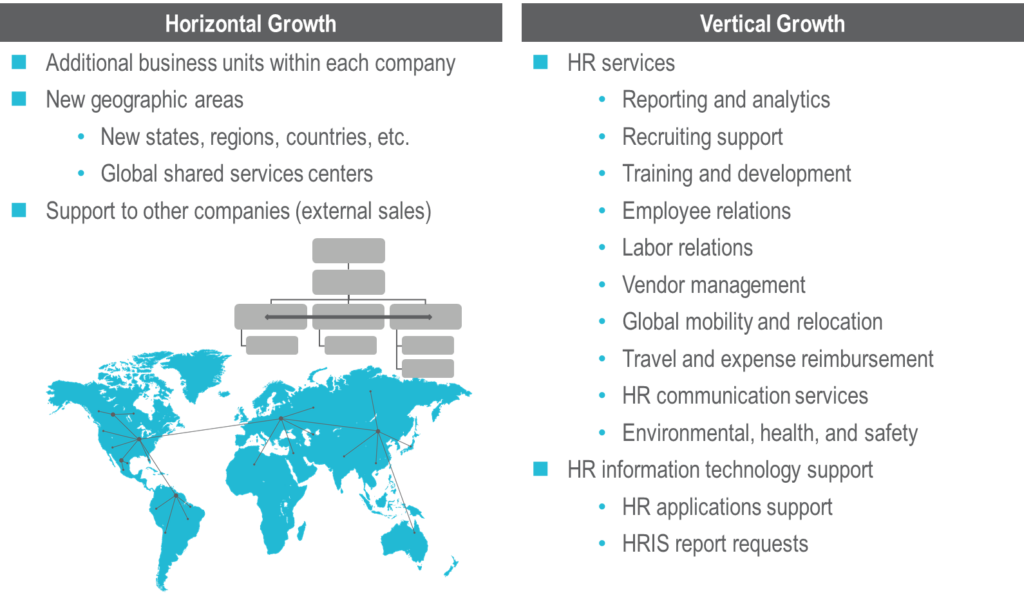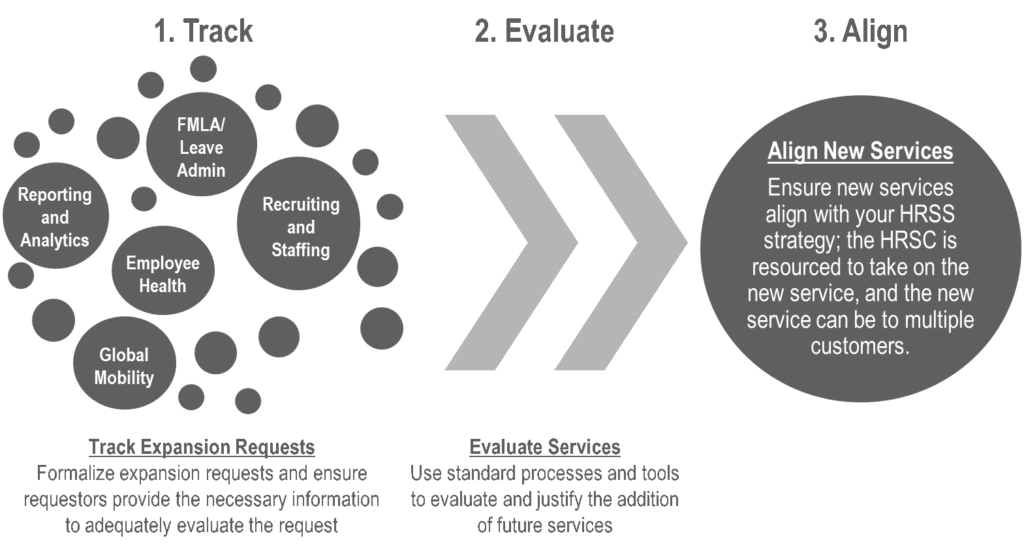
Expanding the Value Proposition of Shared Services
With maturity in shared services comes the question—how can you continue to realize value from a shared services enterprise? Once the initial scope and operation has stabilized, leaders are often challenged to determine how the benefits of shared services can be expanded. What is the best way to increase the value that your organization delivers? How do you go about adding services or increasing scale? How do you continue to leverage the benefits of shared services? In this article, we discuss strategies for expanding services and value, common challenges that shared services leaders encounter, and steps to successfully execute value expansion within your shared services organization (SSO).
Service Expansion Strategies
Once a shared services delivery model has been implemented successfully within an organization, there are two primary strategies for expansion—horizontal or vertical growth.
Horizontal growth considers expansion of your initial scope to additional customers or business units. This type of growth includes adding new geographic areas or expanding scope to provide global coverage. It may include adding complex states, countries, or business units that were not ready for the initial launch of services, or it may include companies or business units acquired since the initial launch. Vertical growth refers to adding additional services to the scope of the SSO. This may include employee-facing services that are not traditionally supported by the HR service center’s scope, such as travel and expense reimbursement or system access requests (Figure 1).
Figure 1: Expansion Strategies – Horizontal vs. Vertical Growth

A vertical expansion trend that is increasing in SSOs is the move toward providing higher-value consultative and/or advisory services to customers. This trend is documented by recent SSON research which states, “while only one out of 10 shared services today is focused mainly on knowledge services, 70% of survey respondents confirm that they are actively shifting in this direction.”[1] We see an even stronger trend when we analyze shared services maturity. The more mature the SSO, the less its focus on transactional work and the more we see a shift toward knowledge-centered work. The highest ratio of knowledge work is performed by SSOs that are at least 10 years old. These services are typically delivered by a Tier 2, or specialist group, with training and skills well-suited for the role. In HR, this may include an SSO that manages employee relations cases or performs HR reporting and analytics. In finance, higher-level services can include financial planning and analysis and forecasting. Cross-functional services that fall into this category are services such as communication services, regulatory compliance, and facilities management.
Ideas for service expansion can be generated from a variety of sources. Sometimes an SSO leader is negatively impacted by an inefficient process, leading to a desire to incorporate that process into their purview. Sometimes proposals originate from executives looking to shift a process that is considered difficult or a nuisance to an alternative owner. Pressures to further reduce costs also create opportunities for expansion. In all cases, the potential new service should be evaluated and justified with a standard set of processes and tools. The service should be analyzed to determine alignment with strategy, resource, and service level impact and the ability to leverage the service across all customer groups (Figure 2). Once a clear plan to clean or fix the process before go-live is established, the decision to transition a service into the SSO scope should be approved by leadership.
Figure 2: Keys to Successfully Adding New Services

Common Challenges in Service Expansion
SSO leaders share a number of common challenges encountered while working to expand the value of their organization. Often there are expectations for growth in service delivery without any accommodations for additional headcount to support the work. In these cases, innovation must be applied and the processes should be redesigned with efficiency and optimization opportunities in mind. Investment in technology or automation, like robotic process automation, can be considered as part of the business case for transition of the service. Therefore, another challenge to service expansion is the increase in investment requirements—either at the outset of service transition or over time—that may be added to the SSO.
Taking on additional services can also impact service levels and responsiveness. To mitigate this risk, service level goals should be agreed on amongst stakeholders, and performance improvement should be forecasted and communicated. Metrics for the new service should be tracked separately from existing services. If there is a significant impact to existing services, standalone metrics allow the root cause to be identified, explained, and remedied.
Expanding the service offerings of an SSO can also come with additional bureaucracy, especially if there are joint lines of responsibility for a service or if additional stakeholders need to be involved with decision making. Establishing simple governance for the process at the outset of the transition with clear roles and responsibilities will enable the organization to be nimble in delivering the service.
Successful Execution of Value Expansion
As is true of any initiative, governance and diligence are key to successful execution of your service expansion. A plan should be developed to keep the organization oriented to tasks and an agreed-upon completion date for the launch of the service. Decision makers and key stakeholders should be identified and included in a routine cadence of communications. By following these steps, the SSO will be well-prepared to execute the new service for their customers:
Step 1: Establish a baseline from current state
Step 2: Identify improvement opportunities for the future state
Step 3: Develop the business case
Step 4: Develop the service transition and training plan
Step 5: Measure the results
ScottMadden has experience helping clients with successful value and service expansion within their SSOs. Contact us to learn more.
[1] SSON 2017 State of the Shared Services Industry Report. www.ssonetwork.com
View MoreSussex Economic Advisors is now part of ScottMadden. We invite you to learn more about our expanded firm. Please use the Contact Us form to request additional information.